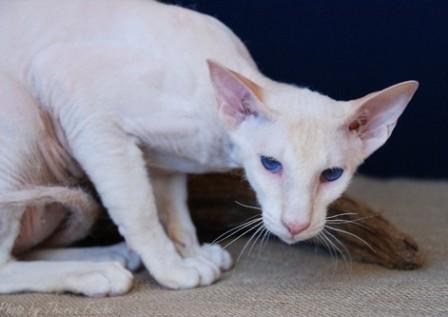Introduction
The Peterbald cat is an elegant and unique breed, renowned for its distinctive coat and charming personality. Originating from Russia, this breed has garnered interest worldwide due to its varied coat types and affectionate nature. This comprehensive guide explores the Peterbald’s history, characteristics, personality traits, genetic makeup, health considerations, and care requirements, providing a thorough understanding for enthusiasts and potential owners.
History and Origin
The Peterbald cat’s journey began in Russia in 1988 with the discovery of an unusual coat in a cat named Varvara from Rostov-on-Don. This cat exhibited a hairless or near-hairless coat, sparking interest among breeders. Initially referred to as Don Sphynx, this breed was crossbred with the Oriental Shorthair in St. Petersburg by cat breeder Olga S. Mironova. This strategic breeding led to the official creation of the Peterbald breed in 1993. Named after the city of St. Petersburg, the breed quickly gained recognition. In 1996, the breed was officially recognized by the International Cat Association (TICA), and by 2005, it was eligible for championship competition.
Characteristics and Appearance
Peterbald cats are medium-sized and possess a sleek, muscular build, reminiscent of their Oriental Shorthair ancestors. Their body shape is long and slender, contributing to their graceful and elegant appearance. The most striking feature of the Peterbald is its coat, or lack thereof. The breed’s coat can range from completely hairless to having a fine peach-fuzz texture. Some Peterbalds may have a velvety or bristly coat, while others possess a combination of these textures. This variety in coat types is due to the breed’s genetic diversity.
The Peterbald’s head is narrow and wedge-shaped, with pronounced cheekbones and a straight profile. Their almond-shaped eyes can come in various colors, adding to their exotic look. Large, wide-set ears enhance their alert and curious expression. The breed also features a distinctive whip-like tail and webbed feet, which enable them to grasp objects and exhibit playful behavior.
Personality and Temperament
Peterbald cats are celebrated for their high intelligence, affectionate nature, and playful demeanor. They are active, curious, and thrive on human interaction, making them excellent companions. Peterbalds are highly social cats that form strong bonds with their owners and often follow them around the house. They enjoy engaging in vocal communication, expressing their needs and desires through various sounds.
These cats are also known for their friendly and gentle temperament, which makes them well-suited for families with children and other pets. Peterbalds are not solitary animals; they crave companionship and can become lonely if left alone for extended periods. Their playful nature means they enjoy interactive toys and games, which keep them mentally and physically stimulated.
Genetic Traits and Inheritance
The unique coat of the Peterbald is a result of a dominant gene for hairlessness or altered hair growth. This gene can produce a range of coat types, from completely hairless to various degrees of fuzziness. When two Peterbalds are bred, their offspring can exhibit a mix of coat types. Approximately 25% of the kittens may be born entirely hairless, while others may have different textures of fur.
The genetics behind the Peterbald’s coat variation follow basic Mendelian principles. However, there are complexities in how hair loss and retention are expressed. Breeding programs must carefully consider these genetic factors to maintain the breed’s health and diversity.
Health Considerations
Peterbald cats are generally healthy, but their unique coat and genetic makeup can make them prone to certain health issues. One significant concern is feline ectodermal dysplasia, a condition that affects hair, teeth, and skin. This genetic disorder can lead to problems with dentition and lactation in affected cats.
Regular health check-ups and responsible breeding practices are essential to ensure the well-being of Peterbald cats. Prospective owners should seek reputable breeders who conduct genetic testing and follow ethical breeding guidelines. Additionally, owners should be vigilant about their cat’s health, ensuring they receive proper veterinary care and a balanced diet.
Care and Maintenance
Due to their unique coat, Peterbald cats require specific care and maintenance. Hairless or minimally coated Peterbalds need regular skin cleaning to prevent oil buildup, which can lead to skin issues. A gentle wipe-down with a damp cloth or baby wipe can help keep their skin clean and healthy.
Peterbalds are also sensitive to extreme temperatures. Without the protection of a full fur coat, they can easily become cold or sunburned. Owners should provide warm clothing or blankets during colder months and ensure their cats are protected from direct sunlight.
Despite their delicate appearance, Peterbalds are active and robust cats. They require a balanced diet to maintain their energy levels and overall health. Regular exercise through playtime and interactive toys is crucial to keep them mentally and physically stimulated.
Feeding and Nutrition
Feeding a Peterbald cat requires careful consideration of their nutritional needs. A balanced diet rich in high-quality protein is essential to support their active lifestyle and maintain muscle mass. Owners should consult with their veterinarian to determine the best diet plan for their individual cat, taking into account factors such as age, weight, and health status.
Peterbalds may also benefit from a diet that includes omega-3 and omega-6 fatty acids, which promote healthy skin and coat. These nutrients can be found in fish oil supplements or specialized cat food formulations.
Grooming
Grooming a Peterbald cat is relatively straightforward compared to other breeds, but it still requires regular attention. Hairless or minimally coated Peterbalds need frequent baths to remove excess oils from their skin. Using a gentle, hypoallergenic cat shampoo is recommended to avoid skin irritation.
For Peterbalds with a velvety or bristly coat, regular brushing can help remove loose hairs and keep their coat in good condition. Brushing also provides an opportunity to check for any skin issues or abnormalities.
Behavioral Traits
Peterbald cats are known for their affectionate and social behavior. They enjoy being around people and are often described as “dog-like” in their loyalty and attachment to their owners. This breed is also highly intelligent and can be trained to perform tricks or follow commands.
Due to their social nature, Peterbalds can experience separation anxiety if left alone for long periods. Providing plenty of interactive toys, scratching posts, and climbing structures can help keep them entertained and reduce stress.
Training and Socialization
Training a Peterbald cat can be a rewarding experience due to their high intelligence and eagerness to please. Positive reinforcement techniques, such as treats and praise, work well with this breed. Basic commands, litter box training, and leash training can all be accomplished with patience and consistency.
Socializing a Peterbald kitten from a young age is crucial to ensure they develop into well-adjusted adult cats. Exposing them to different environments, people, and other animals helps build their confidence and reduces the likelihood of behavioral issues.
Common Health Issues
While Peterbalds are generally healthy, they can be predisposed to certain genetic and health conditions. Feline ectodermal dysplasia is one such condition that affects the breed. Regular veterinary check-ups and genetic testing can help identify and manage potential health issues early on.
Other common health concerns for Peterbalds include dental problems, skin infections, and sensitivity to temperature changes. Owners should be proactive in monitoring their cat’s health and seeking veterinary care when needed.
Finding a Reputable Breeder
Finding a reputable breeder is essential when looking to adopt a Peterbald cat. Prospective owners should research breeders thoroughly, ensuring they follow ethical breeding practices and prioritize the health and well-being of their cats. Visiting the breeder’s facility and meeting the kittens and their parents can provide insight into the breeding environment and the care provided.
Reputable breeders will also provide health guarantees and documentation of genetic testing. They should be willing to answer any questions and offer support throughout the cat’s life.
Adoption and Rescue
Adopting a Peterbald cat from a rescue organization or shelter is another option for potential owners. Many purebred cats, including Peterbalds, can end up in shelters due to various circumstances. Adopting from a rescue can provide a loving home to a cat in need and support the mission of animal welfare organizations.
Conclusion
The Peterbald cat is a fascinating and rare breed, admired for its distinctive appearance and loving personality. Ideal for families and individuals seeking a loyal and interactive pet, Peterbalds bring joy and companionship to their owners. Understanding their unique needs and genetic background ensures a happy and healthy life for these remarkable cats. Whether adopted from a breeder or rescue organization, Peterbalds make a wonderful addition to any home, offering endless affection and entertainment.

